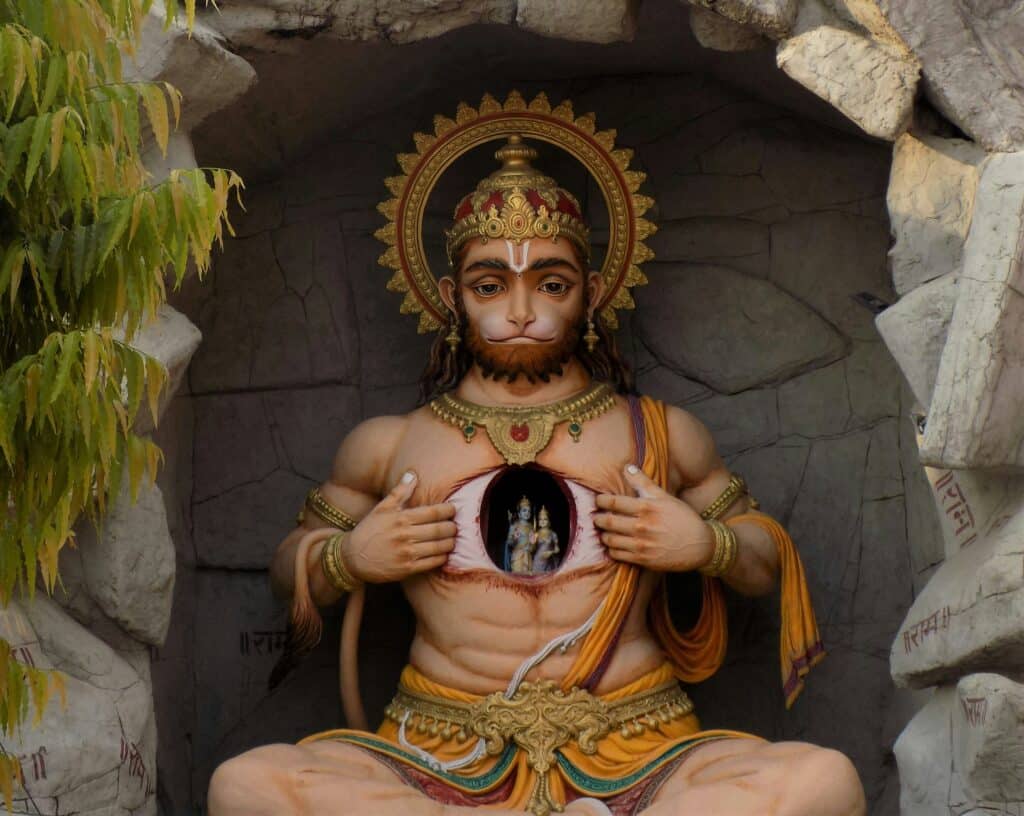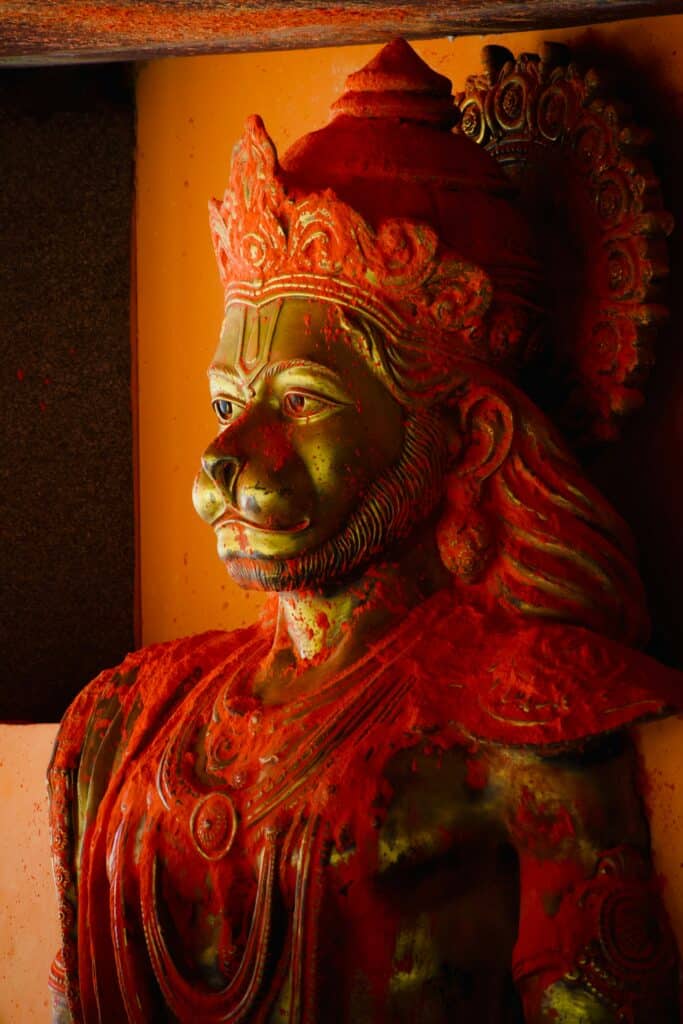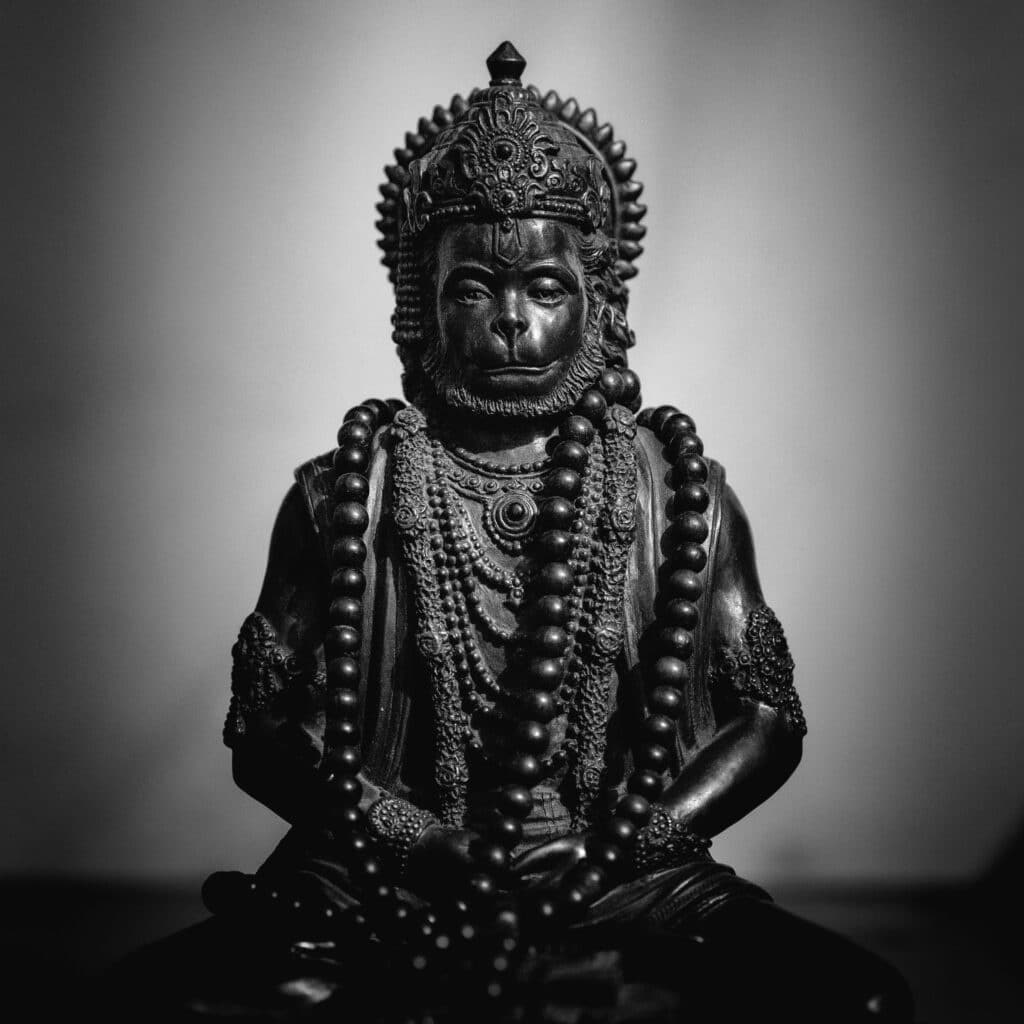Discovering the Hanuman Chalisa and Modern Bhakti Yoga
Discovering the Hanuman Chalisa and Modern Bhakti Yoga
The Hanuman Chalisa is a 17th-century chant dedicated to the revered monkey warrior-god, Hanuman. Written by Goswami Tulsidas, a prominent Indian Bhakti poet, this powerful text is a cornerstone of Bhakti Yoga, which emphasizes devotion through practices like mantra and song, often performed in the form of “kirtan.” The Sanskrit word “kirtan” means ““to call, recite, praise, or glorify.”

Recently we were able to spend two months at Lake Atitlan, in San Marcos la Laguna, surrounded by the volcanoes of central Guatemala. The key highlights of this time were the almost-daily kirtan circles and devotional chanting that can be found around Atitlan. There are so many spiritual-type people living and traveling in San Marcos and the surrounding area. All of those community kirtan events really showed us how powerful bhakti yoga can be.

The term “Chalisa” translates to “40,” referring to the number of verses within this ancient lyrical composition, the Hanuman Chalisa. Legend has it that Tulsidas penned these verses at Tulsi Ghat on the banks of the Ganga in Varanasi, where the original pages were housed in a Hanuman temple until they were unfortunately stolen in 2011.

Chanting mantras has become a part of our daily practice.
Written in the Awadhi language, which derives its name from the ancient city of Ayodhya— the capital of the world in the epic Ramayana— the Hanuman Chalisa is more than just a poetic work. Tulsidas also authored the Ramcharitmanas, a retelling of the Ramayana designed to be more accessible than the original Sanskrit text. Although Awadhi was a dominant literary language in India, it has since been largely overshadowed by Hindi since the 19th century. Nonetheless, around 39 million people in Uttar Pradesh, Northern India, still speak it today.

The Hanuman Chalisa glorifies the monkey god Hanuman for his heroic deeds in the Ramayana, one of Hinduism’s most cherished epics of mythology. In this epic tale, Ram—the King of the World and the seventh avatar of Lord Vishnu—embarks on a journey alongside his loyal brother, Lakshmana, to confront the evil demons of Lanka.
During the narrative, Hanuman is entrusted with the critical mission of saving Lakshmana by retrieving medicinal herbs. In an awe-inspiring display of strength, Hanuman flies from Sri Lanka to the Himalayas in search of these rare herbs. Upon arriving, he realizes he cannot identify them among the plethora of plants available. In a moment of determination, he lifts the entire mountain and carries it back to Lanka, where he drops it in the middle of the battlefield, enabling the swift healing of Prince Lakshmana.
My partner, Carrie, and I have cherished our connection to Hanuman and these captivating stories since our time in Sri Lanka. Nestled along the southern coast, Unawatuna is renowned for its beautiful beaches, excellent surfing, and delightful dining options, making it a popular tourist destination. During the Tuk Tuk Tournament—an adventurous journey across Sri Lanka—we had to visit the Japanese Peace Pagoda in Unawatuna. Perched atop Rumassala Mountain, the temple offered stunning views of the coastline, and was the perfect location to witness the sunset.

Japanese Peace Pagoda temple in Unawatuna on top of Hanuman’s Mountain.
Rumassala Mountain is considered to be one of the five pieces that broke off of Sanjeevani Mountain when Hanuman uprooted a portion of it to save Lakshmana. Rumassala Mountain itself is a special place, as it is said to contain more than 150 herbs, many of which are endemic and medicinal. The soil composition at the site is even differs from that of the surrounding area. Locals say many of the herbs there grow only there and in the Himalayas, thousands of miles apart— a fact that is attributed to Hanuman’s mountain-carrying act of service.
We learned about these enchanting tales early on in our yoga journeys. I find it utterly fascinating how stories in nature resonate with mystical legends. Regardless of their truth, such beautiful coincidences abound. In her yoga classes, Carrie frequently shares the tale of Hanuman’s mountain, inspiring her students with its depth and significance.
It is said that as long as the Ramayana is recited, Hanuman remains a presence in our world. The Hanuman Chalisa serves as a prayer that conveys this timeless story. With its 40 verses, committing the Chalisa to memory is no small task; while Carrie can recite it by heart, I find comfort in reading along. Despite my years of practice and countless listenings, I still struggle to keep pace with the chant.
If you’re interested in learning the Hanuman Chalisa, I recommend following along with a recording. After a few tries, you’ll find it easier to start voicing the words yourself. There are many versions available on Spotify and YouTube; I particularly enjoy the Ananda Das version, which can be found here.
The Hanuman Chalisa is not only a spiritual chant but also a profound connection to a rich tapestry of culture and devotion that resonates in modern Bhakti Yoga practices. Embracing its teachings can enrich your meditation and yoga journey, fostering a deeper understanding of devotion and service. We try to bring Bhakti Yoga sessions into our retreats. Sometimes this is some guitar around the fire, sometimes it’s with gongs and singing bowls. There are many ways to connect to the divine.
Below, you’ll find the full text of the Hanuman Chalisa, accompanied by a simple translation to help you grasp its essence and meaning.

HANUMAN CHALISA
Mangala muratimarutanandana Sakala amangala mula nikandana Mangala muratimarutanandana Sakala amangala mula nikandana
Shree Guru charana saroja raja nija manu mukuru sudhari Baranaun Raghubara bimala jasu jo daayaku phala chaari Budhi heena tanu jaanike sumiraun pawana kumaara Bala budhi vidyaa dehu mohin harahu kalesa bikaara Siya vara raamachandra pada jai sharanam
- Jaya Hanumaan gyaana guna saagara
Jaya Kapeesha tihun loka ujaagara
- Raama doota atulita bala dhaamaa
Anjani putra Pawanasuta naamaa
- Mahaabeera bikrama bajarangee
Kumati niwaara sumati ke sangee
- Kanchana barana biraaja subesaa
Kaanana kundala kunchita kesaa
- Haata bajra aura dwajaa biraajai
Kaandhe moonja janeu saajai
- Shankara suwana Kesaree nandana
Teja prataapa mahaa jaga bandana
- Bidyaawaana gunee ati chaatura
Raama kaaja karibe ko aatura
- Prabhu charitra sunibe ko rasiyaa
Raama Lakhana Seetaa mana basiyaa
- Sookshma roopa dhari Siyahin dikhaawaa
Bikata roopa dhari Lankaa jaraawaa
- Bheema roopa dhari asura sanghaare
Raamachandra ke kaaja sanvaare
- Laaya sajeevana Lakhana jiyaaye
Shree Raghubeera harashi ura laaye
- Raghupati keenhee bahuta baraaee
Tuma mama priya Bharatahi sama bhaaee
- Sahasa badana tumharo jasa gaawai
Asa kahi Shreepati kanta lagaawai
- Sanakaadika Brahmaadi muneesaa
Naarada Saarada sahita Aheesaa
- Yama Kubera digapaala jahaante
Kabi kobida kahi sake kahaante
- Tuma upakaara Sugreevahin keenhaa
Raama milaaya raaja pada deenhaa
- Tumharo mantra Bibheeshana maanaa
Lankeshwara bhaye saba jaga jaanaa
- Yuga sahasra yojana para bhaanu
Leelyo taahi madhura phala jaanu
- Prabhu mudrikaa meli mukha maaheen
Jaladhi laanghi gaye acharaja naaheen
- Durgama kaaja jagata ke jete
Sugama anugraha tumhare tete
- Raama duaare tuma rakhawaare
Hota na aagyaa binu paisaare
- Saba sukha lahai tumhaaree sharanaa
Tuma rakshaka kaahu ko daranaa
- Aapana teja samhaaro aapai
Teenon loka haanka ten kaanpai
- Bhoota pisaacha nikata nahin aawai
Mahaabeera jaba naama sunaawai
- Naasai roga hare saba peeraa
Japata nirantara Hanumata beeraa
- Sankata ten Hanumaana churaawai
Mana krama bachana dhyaana jo laawai
- Saba para Raama tapaswee raajaa
Tina ke kaaja sakala tuma saajaa
- Aura manorata jo koee laawai
Soee amita jeewana phala paawai
- Chaaron juga parataapa tumhaaraa
Hai parasidha jagata ujiyaaraa
- Saadhu santa ke tuma rakhawaare
Asura nikandana Raama dulaare
- Ashta siddhi nau nidhi ke daataa
Asa bara deena Jaanakee Maataa
- Raama rasaayana toomhare paasaa
Sadaa raho Raghupati ke daasaa
- Tumhare bhajana Raama ko paawai
Janama janama ke dukha bisaraawai
- Anta kaala Raghubara pura jaaee
Jahaan janama Hari bhakta kahaaee
- Aura devataa chitta na dharaaee
Hanumata se-ee sarva sukha karaee
- Sankata katai mite saba peeraa
Jo sumire Hanumata bala beeraa
- Jai jai jai Hanumaana Gosaaee
Kripaa karahu gurudeva kee naaee
- Jo sata baara paata kara koee
Chootahi bandi mahaa sukha hoee
- Jo yaha parai Hanumaana chaleesaa
Hoya siddhi saakhee Gaureesaa
- Tulasee Daasa sadaa Hari cheraa
Keejai naata hridaya mahan deraa
Pawanatanaya sankata harana mangala moorati roopa
Raama Lakhana Seetaa sahita hridaya basahu sura bhoopa
Siya vara raamachandra pada jai sharanam
—
Hanuman Chalisa – English Translation
Invocation:
Having polished the mirror of my heart with the dust of my Guru’s lotus feet,
I sing the pure fame of the best of the Raghus (Lord Rama), which bestows the four fruits of life.
Knowing this body to be without intelligence, I remember the Son of the Wind (Hanuman).
Grant me strength, intelligence, and knowledge, and remove my sorrows and flaws.
The four fruits of life referred to here are the traditional goals in Hindu philosophy:
Dharma (righteousness),
Artha (prosperity),
Kama (pleasure), and
Moksha (liberation).
Verses
- Hail to Hanuman, the ocean of wisdom and virtue,
Hail Monkey Lord, illuminator of the three worlds.
- You are Ram’s emissary, and the abode of matchless power,
Anjani’s son, named the “Son of the Wind.”
- Great hero, you are as mighty as a thunderbolt,
You remove evil thoughts and are the companion of the good.
- Golden hued and splendidly adorned,
With heavy earrings and curly locks.
- In your hands shine mace and banner,
And a sacred thread adorns your shoulder.
- You are Shiva’s son and Kesari’s joy,
Your glory is revered throughout the world.
- You are the wisest of the wise, virtuous and clever,
Ever intent on doing Ram’s work.
- You delight in hearing of the Lord’s deeds,
Ram, Sita, and Lakshman dwell in your heart.
- Assuming a tiny form you appeared to Sita,
And in an awesome form, you burned Lanka.
- Taking a dreadful form, you slaughtered the demons,
And completed Lord Ram’s mission.
- You brought the life-giving herb and revived Lakshman,
And Ram embraced you with delight.
- The Lord of the Raghus praised you greatly:
“Brother, you are dear to me as Bharat!”
- “May the thousand-mouthed serpent sing your fame!”
So saying, Lakshmi’s Lord drew you to Himself.
- Sanak and the sages, Brahma, Narada, Saraswati, and the King of Serpents,
All sing your glories.
- Yama, Kubera, and the guardians of the directions,
Poets and scholars — none can express your glory.
- You did great service for Sugriva,
Presenting him to Ram, you gave him the kingship.
- Vibhishana heeded your counsel,
And became the Lord of Lanka, known throughout the world.
- You swallowed the sun, thinking it a sweet fruit,
Though it was thousands of miles away.
- With Ram’s ring in your mouth,
You leapt across the ocean — no surprise!
- All difficult tasks in this world
Become easy by your grace.
- You are the guardian at Ram’s door,
No one enters without your permission.
- Those who take refuge in you find happiness,
Those you protect know no fear.
- You alone can withstand your own splendor,
The three worlds tremble at your roar.
- Ghosts and demons flee
When your name is uttered.
- Disease and pain disappear
With constant repetition of your name.
- You rescue from affliction
Those who remember you in thought, word, and deed.
- Ram, the ascetic, reigns over all,
But you carry out his every task.
- Those who come to you with any yearning
Obtain the abundance of life.
- Your splendor fills all four ages,
And your fame shines throughout the world.
- You are guardian of saints, destroyer of demons,
Beloved of Ram.
- You grant the eight powers and nine treasures,
By boon from Mother Janaki.
- You hold the elixir of Ram’s name,
And remain eternally his servant.
- Through your praise one finds Ram,
And escapes the sorrows of countless lives.
- At death, one goes to Ram’s abode
Or is born as a devotee of God.
- Give no thought to other deities,
Worship Hanuman to gain all joy.
- All suffering ceases
When Hanuman’s name is remembered.
- Victory, Victory, Victory to Lord Hanuman!
Bless me as my guru
- Who recites this a hundred times
Is freed from bondage and gains great bliss.
- One who reads this Hanuman Chalisa
Gains success — Lord Shiva is witness.
- Says Tulsidas, always Hari’s servant:
“Lord, dwell in my heart and soul.”
Closing Verse:
Son of the Wind, destroyer of sorrow, embodiment of blessings,
Live in my heart, King of Gods, with Ram, Lakshman, and Sita.

